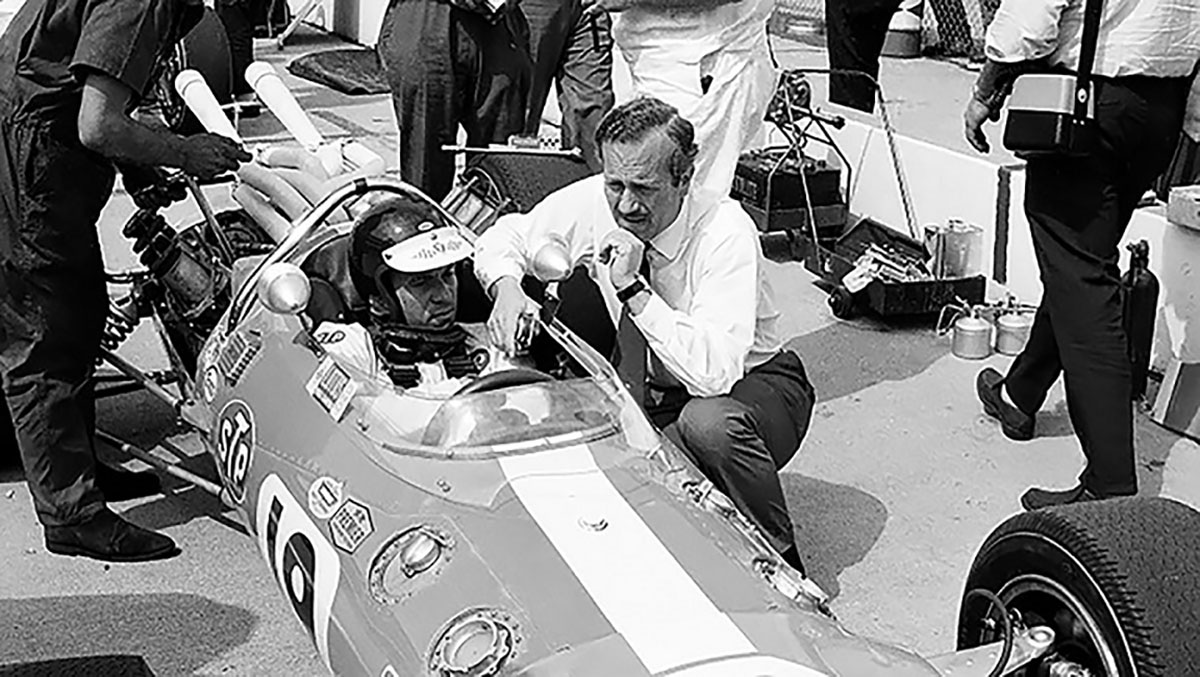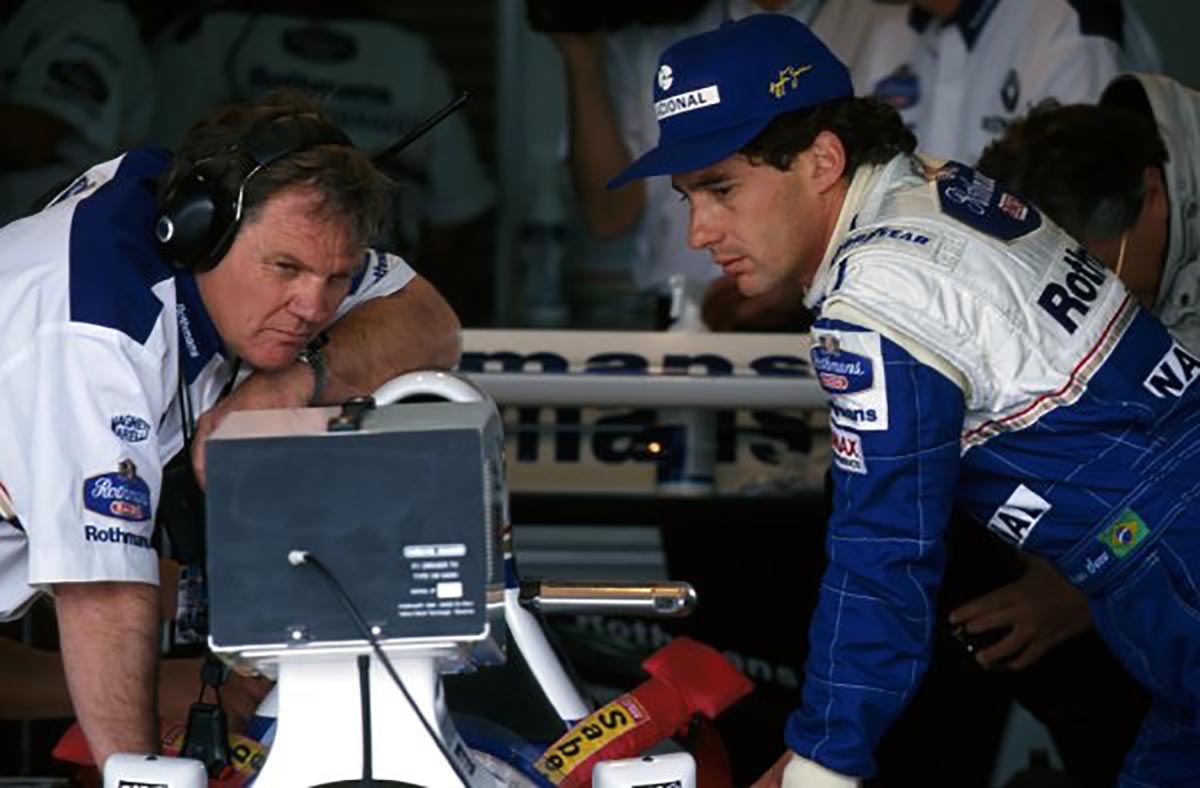The months of April and May bring sad reminders of three great F1 heroes lost to crashes – Jimmy Clark, Gilles Villeneuve and Ayrton Senna. All are sorely missed. We can be grateful that Niki Lauda, whose passing in May of 2019 was a reminder of a long and inspiring life, escaped from his fiery crash at the Nürburgring. Yet, it was not until the fatal crash of Senna in 1994 that a safety revolution took place. This excerpt from “CRASH!” looks at why the great Brazilian’s death made so much difference when it came to racing safety, now part of his legacy.
The Death of Senna
Those in racing who were closer to Senna tended to present him in a more nuanced light. One of those was Dr. Sidney Watkins, the head of neurosurgery at the London Hospital. The medical officer of Formula 1 was known as Professor or “Prof” Watkins. He became a friend and confidant of the Brazilian driver, who arrived not long after Watkins first took responsibility for ensuring a prompt medical response to drivers involved in crashes. (This was at the behest of Formula 1’s hard-driving businessman Bernie Ecclestone, who perhaps foresaw the need for greater safety and the politically risky prospect of drivers getting killed during the live TV coverage he was so instrumental in organizing.)
Watkins, in his book “Life at the Limit, Triumph and Tragedy in Formula One,” recalls the time when Senna made a visit to the Loretto School, Scotland’s oldest boarding school located near Edinburgh. Watkins’ stepson Matthew Amato was enrolled at Loretto and had requested a visit from Senna in a letter that was hand-delivered by Watkins.
There was great interest in Formula 1 at Loretto. Jim Clark, the two-time World Champion, had attended the school and the Clark family’s farm was located in the rolling hills of the nearby Borders district. Senna’s visit came prior to the start of the 1991 season and shortly after he had won his second World Championship—– the one he had clinched by intentionally taking Alain Prost off the track in Japan. After walking through the memorial to Clark in the chapel, Senna addressed the high school enrollment during the mandatory bi-weekly Saturday evening lecture, which usually featured speakers from industry or medicine.
“We thought Ayrton would be a good one to have,” recalled Amato in an interview 20 years later. He was 15 at the time he requested the visit by having his stepfather deliver the letter to Senna. “He gave a really good talk about what it takes to be a Formula 1 driver and about Jim Clark. He said he liked the fact that Jim Clark always had a smile.”
The bulk of the lecture was a question and answer session and the first question came from a future barrister. It was about rival Prost and what he thought of him? “Wow, first question!” said Senna, who went on to praise his rival in some detail.
“It was the etiquette that we had to address the lecturer as ‘Sir’ before we asked a question,” said Amato. “About three or four questions in, he said, ‘You don’t have to call me sir.’ The next question he got, the guy called him ‘Ayrton,’ and he said, ‘Yes, like that.’ By the end, everyone was calling him Ayrton. He answered a lot of good questions about the pressures of the job and even about sponsorship by tobacco.
“He gave very good, thoughtful answers, which I think is not a given for many sportspeople. He was very comfortable talking about his faith in God. It was more from the perspective of answering questions about the danger of his job and was he scared of losing his life? He said he had faith and that helped.”
If there was a comparable driver to Senna, it would have been Clark. Along with Alberto Ascari, they were the three Formula 1 champions considered truly great who died in their race cars.
Clark won everything worth winning, including the Indy 500 and two World Championships. His fame invariably preceded him, but Clark, who became the youngest Formula 1 champion when he won the 1963 title, sustained a down-to-earth outlook more fitting of the mechanics who worked on his cars, an attitude one might expect from the son of a Scottish farmer.
On the track, Clark’s hallmarks were all-round skills and success in a variety of cars, head-and-shoulder dominance of Formula 1 and an ungodly ability to coax speed from even the most ill-handling or demanding machines.
He had an easy manner and smile, but Clark detested the hoopla surrounding such events as the Indy 500. “I started (racing) as a hobby with no idea and no intention of being world champion,” he said in some rare video footage, “I wanted to see what it was like to race on the track.”
Jimmy Clark confirmed his legacy as one of the all-time greats by winning the Indianapolis 500 in Colin Chapman’s Lotus chassis. (Photo courtesy of The Klemantaski Collection)
Apparently, Clark was happiest behind the wheel plying his other-worldly skills. He raced practically non-stop, spending his winters Down Under driving in the Tasman Series for Formula 1 cars, winning the championship in a Lotus 49T in 1968 and presaging what many expected would be a third world title. He drove anything, including a Lotus Cortina taken to the championship in the British Touring Car Series and even a Ford Galaxie at the North Carolina Motor Speedway in a NASCAR Grand National event. He was on board a Lotus Formula 2 car at the Hockenheim circuit in Germany when a suspension failure on his Lotus chassis sent him off the track, into the trees and to his death from a broken neck and skull on April 7, 1968.
In a response eerily similar to the death of Senna 26 years later at Imola, fans and participants in the sport found it hard to believe Clark had died. During a sports car race, an announcement about the crash was made at the Brands Hatch circuit in England where Clark had scored the 1964 British Grand Prix victory. “The place was stumped,” said future racing executive Ian Phillips, a teenager at the time. “People were just staring blankly at one another, standing about in complete and utter silence. The whole place went numb, really.”
The day Clark was killed, he was driving a Lotus chassis in the gold, red and white livery of Gold Leaf Tobacco Company, not the traditional green colors representing Britain that had been used by Lotus and team owner Colin Chapman previously. It marked the beginning of the commercialization of Formula 1, the initial step away from being considered a sport by participants. Instead, it would soon be looked upon as a sport that needed to run itself as a business.
After Clark’s death, there was concern the sport would be outlawed due to the obvious lack of safety represented by the fatal crash of its greatest driver. But the absence of scale when it came to motor racing’s popularity and the lack of broad commercial involvement precluded any great backlash. The tragedy was significant enough to warrant a same day announcement in America on Wide World of Sports by host Jim McKay, who was the broadcaster for the Indy 500 during Clark’s assaults on the Speedway. But regular live TV coverage of Formula 1 was still years away. That, too, helped keep in check the tide of public criticism about the dangers of motor racing.
Almost a decade later, when Niki Lauda crashed at the Nürburgring at the German Grand Prix in 1976, the incident generated a hail of news coverage in racing trade publications. Despite the high-profile of Lauda’s crash, the effort to change the odds in favor of safety ran up against the acceptance and admiration by the racing culture, which held that racing at high speeds necessarily carried inherent risk. Instead, the focus was on giving medals to the two drivers who helped pull Lauda from his burning Ferrari, his gusty return after only six weeks, and James Hunt’s incredible comeback in the season finale at Mt. Fuji to win the title – where Lauda withdrew due to unsafe conditions. The wire services had also covered the crash at the Nürburging, but the general public viewed it as just another motor racing incident.
Six years later, when the much loved, free-spirited, and effervescent Gilles Villeneuve died in Belgium on board a Ferrari during a balls-out qualifying lap, it shocked and saddened the racing world, but did not take it by surprise. Similarly, when Villeneuve’s brilliant young counterpart in rally driving, Henri Toivonen, fatally crashed in Corsica four years later, shock mixed with grief, but the fatal crash was not totally unexpected. The FIA summarily banned the Group B cars used in rallying at the time of Toivonen’s death—the so-called Killer Bs. Otherwise, not much political fallout occurred.
By contrast, the death of Senna, whose estate was valued by some as high as $400 million, occurred when commercialization was in full bloom. His crash in a car powered by Renault and sponsored by the Rothmans International tobacco company was beamed into homes, bars, motor homes, and public houses globally, the same medium that had made the Brazilian driver a leading light in the daily march of sports heroes across TV screens everywhere.
Max Mosley, the FIA President at the time of Senna’s death, had competed in the Formula 2 event in which celebrated champion Clark was killed. In fact, it was his first race. Mosley, a man who believed strongly in individual choice, continued his driving efforts and later became a part-owner of the March Engineering team in F1. As the FIA’s leader, he found himself stunned by the backlash from the media and the public in the aftermath of Senna’s fatal crash.
Major newspaper editorials in Europe expressed doubt about a sport that could kill one of its champions. The racing trade publications blamed the FIA. Even the Vatican weighed in, characterizing F1 as contrary to the human spirit. At first, Mosley backed the risk-taking in F1, saying that mountain climbing and other sports offered the same challenges. But when Karl Wendlinger suffered a severe concussion in the first practice session at Monaco, which left him in a coma, it followed three critical or fatal head injuries at Imola, including the deaths of Roland Ratzenberger and Senna. Mosley changed his perspective overnight and made a major decision on safety.
A half-century after the shift began to permanent circuits to protect fans as a result of public outcry, the FIA was forced to radically change course to protect the sport from political backlash again. This time, the focus was on making the safety of drivers an unquestioned priority.
(Editor’s Note: Jonathan Ingram is in his 44th year of writing on motor racing. His current book is “CRASH! From Senna to Earnhardt — How the HANS Helped Save Racing.” Visit his website for other blogs and special pricing for “CRASH!” during the economic slowdown — https://jingrambooks.com/industry-book/crash )



